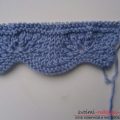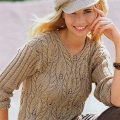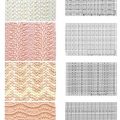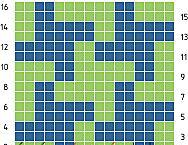
Knitting with the needles of the goose paws pattern with lazy jacquard with the schemes and the detailed description which you can download absolutely free of charge.
In the style of Coco: learn to knit with a needle pattern "goose paw" lazy jacquard The main popularizer of the pattern "goose paw" was Coco Chanel. It is thanks to her, this drawing, called even "chicken legs" or "cock's legs" (from the French "pied-de-poule"), has gained worldwide fame. Despite the fact that the pattern was invented a long time ago, it still remains one of the favorites of the world podiums. 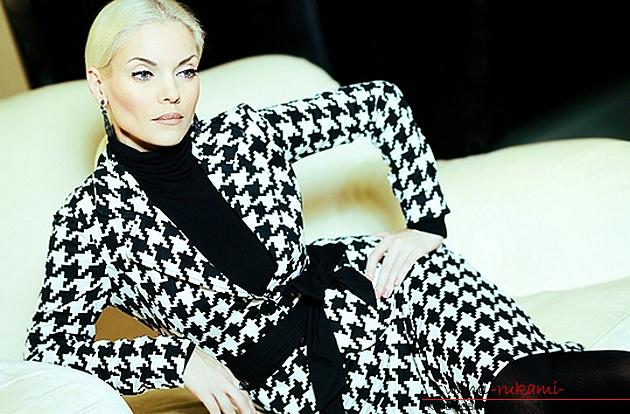 The pattern of "crow's feet" can be confused with the pattern of "pepet", but there are certain differences in them (compare two photos: on the left - "crow's feet", on the right - "peceta"):
The pattern of "crow's feet" can be confused with the pattern of "pepet", but there are certain differences in them (compare two photos: on the left - "crow's feet", on the right - "peceta"): 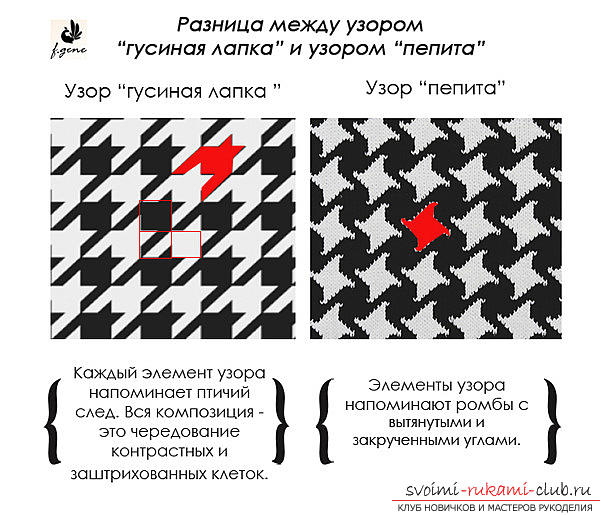
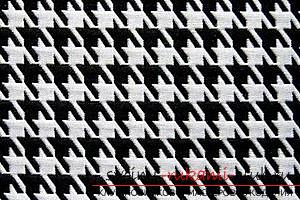
 With the help of the "crow's feet" pattern, you can createpractical any detail of the wardrobe: from a stylish blouse to an elegant coat and even a bag. Most often, such patterns can be associated with two colors: white and black, but there are other combinations of shades. We present several schemes for knitting the "crow's feet" pattern with knitting needles. For the sake of justice, it should be noted that it is possible to work with the same crochet by the same schemes. There are also some interesting schemes of lazy jacquards for this drawing. For example, the pattern of "chicken legs." Numerous collections of fashionable clothes made by this pattern confirm the opinion that such things will never lose their relevance. But how this pattern looks in other colors:
With the help of the "crow's feet" pattern, you can createpractical any detail of the wardrobe: from a stylish blouse to an elegant coat and even a bag. Most often, such patterns can be associated with two colors: white and black, but there are other combinations of shades. We present several schemes for knitting the "crow's feet" pattern with knitting needles. For the sake of justice, it should be noted that it is possible to work with the same crochet by the same schemes. There are also some interesting schemes of lazy jacquards for this drawing. For example, the pattern of "chicken legs." Numerous collections of fashionable clothes made by this pattern confirm the opinion that such things will never lose their relevance. But how this pattern looks in other colors: 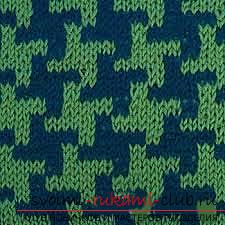
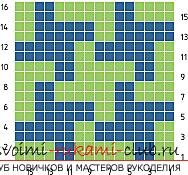 The classical version of this pattern provides forUse of a black and white scale or brown-beige tones. The sample presented above is made of green and blue yarn, which gives it a certain zest and elegance. Naturally, the creation of the classic "crow's foot" pattern will require diligence and attention from you. Today we want to offer you a variant of this pattern, which will require much less time and a little experience. Therefore, even a novice needlewoman can try to connect it. It is based on the technique of "lazy jacquard".
The classical version of this pattern provides forUse of a black and white scale or brown-beige tones. The sample presented above is made of green and blue yarn, which gives it a certain zest and elegance. Naturally, the creation of the classic "crow's foot" pattern will require diligence and attention from you. Today we want to offer you a variant of this pattern, which will require much less time and a little experience. Therefore, even a novice needlewoman can try to connect it. It is based on the technique of "lazy jacquard". 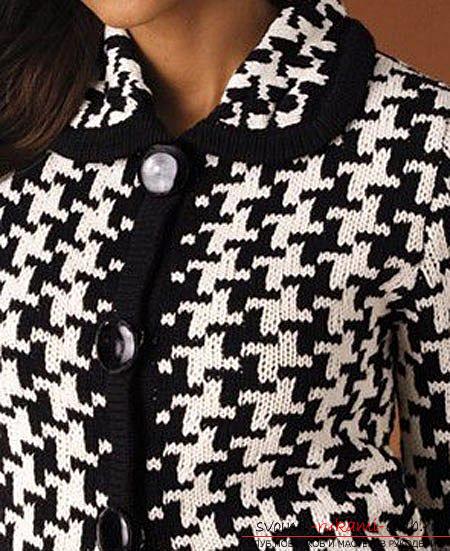 Implementation of such a pattern providesuse of elongated shapes. To create a sample, you need to do a set of the number of loops so that it is a multiple of 6. And do not forget about the 2 nd looped edges at the beginning and end of the row. The first row (white thread): immediately it is necessary to tie a repeating fragment of the pattern: one eyelet needs to be removed, it is important that the thread passes behind the cloth, then the 5 face loops should be tied.
Implementation of such a pattern providesuse of elongated shapes. To create a sample, you need to do a set of the number of loops so that it is a multiple of 6. And do not forget about the 2 nd looped edges at the beginning and end of the row. The first row (white thread): immediately it is necessary to tie a repeating fragment of the pattern: one eyelet needs to be removed, it is important that the thread passes behind the cloth, then the 5 face loops should be tied. 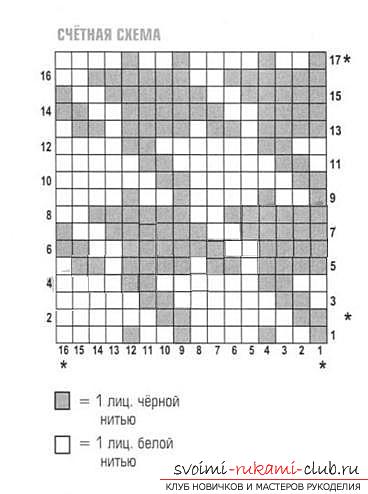 Second row (white thread): Also, you just need to tie a repeating fragment of the pattern: create five purl loops, then one loops need to be removed, it is important that the thread passes in front of the canvas. Third row (black thread): we also need to tie a repeating fragment of our pattern: create five face loops, after which one eyelet should be removed, it is important that the thread passes behind the canvas.
Second row (white thread): Also, you just need to tie a repeating fragment of the pattern: create five purl loops, then one loops need to be removed, it is important that the thread passes in front of the canvas. Third row (black thread): we also need to tie a repeating fragment of our pattern: create five face loops, after which one eyelet should be removed, it is important that the thread passes behind the canvas. 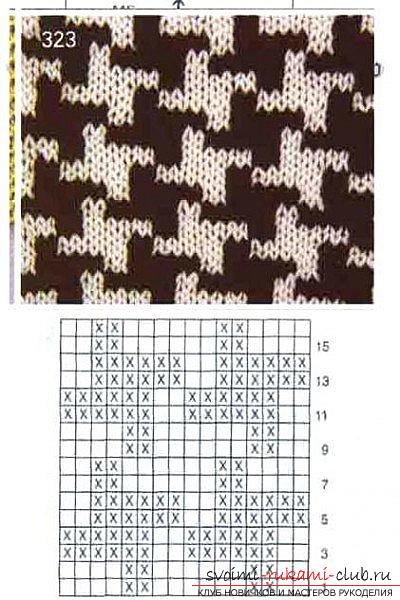 Four ryadochek (black thread): once it is necessary to tie a repeating fragment of the pattern: one eyelet needs to be removed, it is important that the thread passes in front of the canvas, then the five back purlins are tied. Fifth ryadochek (white thread): once you need to tie a repeating fragment of our pattern: three loops need to be removed, it is important that the thread passes in front of the cloth, then tie one eyelet of the front, after which one loop should be removed, it is important that the thread passed behind the canvas, tie a front one of the eyelet. Sixth ryadochek (white thread): also immediately need to tie a repeating fragment of our pattern: create one wrong loop, then one loop should be removed, it is important that the thread passes in front of the canvas, again to tie one wrong loop, then three loops need to be removed , while it is important that the thread runs in front of the blade. Seventh row (black thread): create three face loops, after which one eyelet should be removed, it is important that the thread passes behind the canvas, then tie two face loops. This combination is repeated the whole series. The eighth row (black thread): we also need to tie a repeating fragment of our pattern: create two purl loops, then one loops need to be removed, it is important that the thread passes in front of the fabric, then knit three loops back.
Four ryadochek (black thread): once it is necessary to tie a repeating fragment of the pattern: one eyelet needs to be removed, it is important that the thread passes in front of the canvas, then the five back purlins are tied. Fifth ryadochek (white thread): once you need to tie a repeating fragment of our pattern: three loops need to be removed, it is important that the thread passes in front of the cloth, then tie one eyelet of the front, after which one loop should be removed, it is important that the thread passed behind the canvas, tie a front one of the eyelet. Sixth ryadochek (white thread): also immediately need to tie a repeating fragment of our pattern: create one wrong loop, then one loop should be removed, it is important that the thread passes in front of the canvas, again to tie one wrong loop, then three loops need to be removed , while it is important that the thread runs in front of the blade. Seventh row (black thread): create three face loops, after which one eyelet should be removed, it is important that the thread passes behind the canvas, then tie two face loops. This combination is repeated the whole series. The eighth row (black thread): we also need to tie a repeating fragment of our pattern: create two purl loops, then one loops need to be removed, it is important that the thread passes in front of the fabric, then knit three loops back.  The ninth ryadochek (white thread): to create 2 face loops, one eyelet should be removed, it is important that the thread passes behind the canvas, then tie three face loops. This combination is repeated the whole series. Tenth row (white thread): you also need to tie a repeating fragment of the picture: create three purl loops, then one loops need to be removed, it is important that the thread passes in front of the canvas, then knit the two loops back. The eleventh row (with a black thread): create three facial loops, after which three loops need to be removed, it is important that the thread passes in front of the canvas. This combination is repeated the whole series. The twelfth row with a black thread): immediately it is necessary to tie a repeating fragment of our pattern: three loops need to be removed, it is important that the thread passes in front of the working cloth, then tie three loops back. After that, you should do the repetition of the picture, beginning with the 1st row.
The ninth ryadochek (white thread): to create 2 face loops, one eyelet should be removed, it is important that the thread passes behind the canvas, then tie three face loops. This combination is repeated the whole series. Tenth row (white thread): you also need to tie a repeating fragment of the picture: create three purl loops, then one loops need to be removed, it is important that the thread passes in front of the canvas, then knit the two loops back. The eleventh row (with a black thread): create three facial loops, after which three loops need to be removed, it is important that the thread passes in front of the canvas. This combination is repeated the whole series. The twelfth row with a black thread): immediately it is necessary to tie a repeating fragment of our pattern: three loops need to be removed, it is important that the thread passes in front of the working cloth, then tie three loops back. After that, you should do the repetition of the picture, beginning with the 1st row.

